This post may contain affiliate links. Please read my disclosure and privacy policy.
If you’re looking for a way to frost your favorite holiday cookies without using white refined sugar, this is my new favorite solution.
This coconut sugar icing is made with just a handful of natural ingredients and can be piped onto your favorite holiday cakes and cookies just like the traditional powdered sugar-based frostings.
The key to this icing holding its shape is using a bit of all-natural shortening, which is made from a blend of virgin coconut oil and red palm oil. Normally, I’d never work with “shortening” because it’s too much of an exotic, specialty-type of ingredient, but if you think about it, icing itself is kind of a specialty recipe, right? I mean, we don’t eat frosted sugar cookies on a daily basis, so I’m okay with using a specialty ingredient for a special recipe like this one. Plus, you only need a tablespoon per batch, so this one purchase should last you quite a while!
Just so you know, I did try every combination under the sun to come up with a frosting that didn’t require a shortening-type of ingredient first. Coconut oil and butter are just not the same as shortening when it comes to making a frosting that is stable enough to be stored at room temperature. (They become a soft, melty mess.) If you don’t need your frosting to be sturdy, you can probably sub coconut oil or butter for the palm oil shortening and just store your cookies in the fridge. But, for cookies that can be stored and served at room temperature, give this recipe a try.
I naturally make small batches of recipes when I’m experimenting and found that this amount easily decorated a batch of 12 to 15 small gingerbread cookies. If you need more than that, feel free to double or triple this recipe as needed!
—
Coconut Sugar Icing (Vegan &Paleo)
Makes about 1/2 cup (enough to decorate 12 small cookies)
Ingredients:
1 tablespoon Nutiva red palm oil shortening
1 tablespoon coconut oil (not liquified)
1/4 cup “powdered” coconut sugar
2 tablespoons arrowroot or tapioca starch
1/4 teaspoon vanilla or almond extract (optional)
*I’m not affiliated with Nutiva, but I’m linking to their brand above because that is the only shortening I tried while testing this recipe. I assume other brands would be similar, but I thought I’d share the exact tub I used so you can easily replicate my results.
Directions:
To make “powdered” sugar: Simply grind coconut sugar in a coffee grinder or high-speed blender until it’s finely ground, with a texture similar to powdered sugar. Measure after grinding the sugar for this recipe. (You may have to sift it to help break up clumps.)
To prepare the icing, combine all of the ingredients in a small mixing bowl and stir with a rubber spatula to squish it all together. If you find that you’d like your frosting a little smoother, add a bit of water just 1/2 teaspoon at a time, as needed to thin it out. At this time of the year, I’m guessing almost everyone’s kitchen is cold enough that your coconut oil will be solid at room temperature, but if it isn’t you can place this bowl in the fridge for 30 minutes to help it thicken up!
For decorating, transfer the frosting to a plastic bag fitted with a decorating tip. (I just use a plastic sandwich bag for convenience– cut off the tip on the bottom of one side of the bag, slide in the decorating tip, then add the frosting on top of that.) Gently squeeze the bag and the frosting should easily pipe onto your favorite baked goods.
Due to the nature of grinding your own coconut sugar, this frosting can be a little grainier than traditional frosting, but it goes completely unnoticed once frosted on a cookie! (I know from personal experience.)
(Get the recipe for my vegan & paleo gingerbread cookies here)
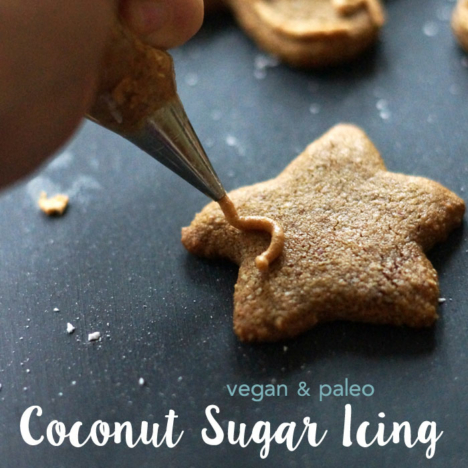
Ingredients
- 1 tablespoon Nutiva red palm oil shortening
- 1 tablespoon coconut oil (not liquified)
- 1/4 cup "powdered" coconut sugar
- 2 tablespoons arrowroot or tapioca starch
- 1/4 teaspoon vanilla or almond extract (optional)
Instructions
- To make "powdered" sugar: Simply grind coconut sugar in a coffee grinder or high-speed blender until it's finely ground, with a texture similar to powdered sugar. Measure after grinding the sugar for this recipe. (You may have to sift it to help break up clumps.)
- To prepare the icing, combine all of the ingredients in a small mixing bowl and stir with a rubber spatula to squish it all together. If you find that you'd like your frosting a little smoother, add a bit of water just 1/2 teaspoon at a time, as needed to thin it out. At this time of the year, I'm guessing almost everyone's kitchen is cold enough that your coconut oil will be solid at room temperature, but if it isn't you can place this bowl in the fridge for 30 minutes to help it thicken up!
- For decorating, transfer the frosting to a plastic bag fitted with a decorating tip. (I just use a plastic sandwich bag for convenience-- cut off the tip on the bottom of one side of the bag, slide in the decorating tip, then add the frosting on top of that.) Gently squeeze the bag and the frosting should easily pipe onto your favorite baked goods.
Nutrition
Per Serving: Calories: 432, Fat: 27g, Carbohydrates: 46g, Fiber: 1g
Note: If you’re concerned about using red palm oil, Nutiva’s organic palm oil is grown in Ecuador and doesn’t contribute to habitat destruction the way red palm oil in Southeast Asia can. You can read more about Nutiva’s red palm oil here. Because red palm oil also contains high levels of Vitamin A and E, it has a buttery yellow color that is surprisingly similar to a tub of margarin– I was really surprised by this when I first started working with it.
Hope you enjoy it over some gingerbread cookies this year!
—
Reader Feedback: What’s your go-to frosting recipe?

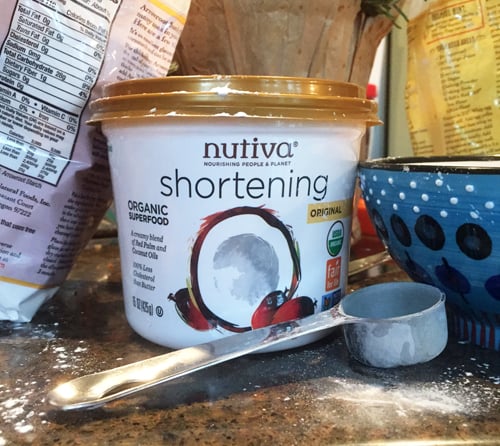
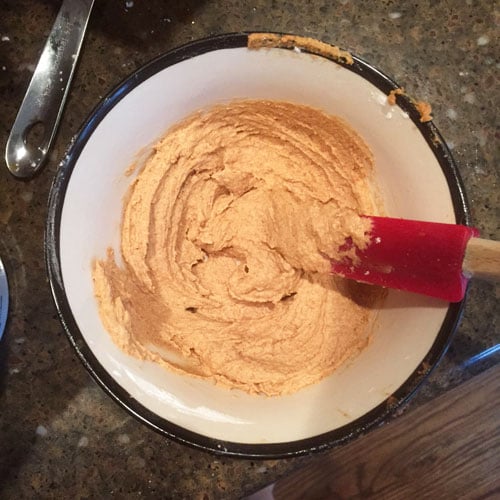


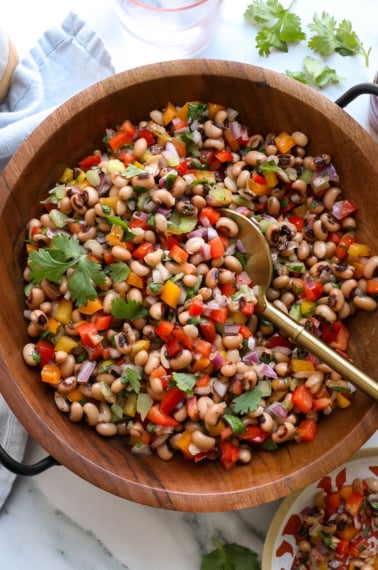
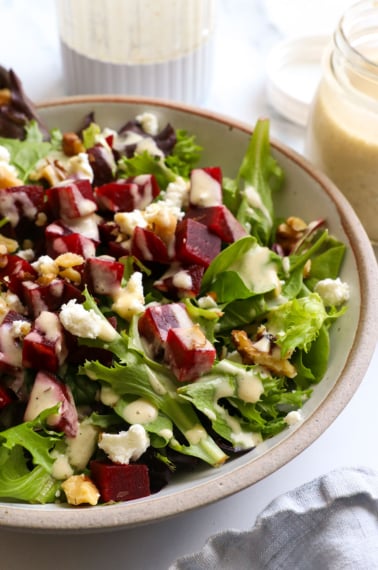








Any sub ideas for arrowroot or all starches?
Hi, does this icing dry hard like the original royal icing made with egg whites?
No, it never dries that hard. The top can sort of dry out overnight, but it’s not super sturdy like royal icing.
I’m looking for a royal icing recipe made with coconut sugar. Have you tried this?
I understand that tapioca needs to be cooked, which I didn’t see in the recipe, to protect stomach lining. I did cook it. The result was acceptable as a glaze.
Would you mind sharing a link to that research so I can learn more about it? Thanks!
Would use if not for the palm oil. It’s a huge driver of deforestation and there’s not a lot of accountability, even with “fair trade” brands. Any alternatives to the shortening? Arrow root powder or cacao butter maybe?
If you can find Miyoko’s vegan butter (it’s at Trader Joe’s and Whole Foods) I’ve been using that this year instead of the shortening and it works really well! It’s made from coconut oil and cashews.
Have you ever tried to add natural food colorings? With it being brown I’m guessing it probably won’t work well but I’m feeling optimistic.